Experience a day of filmmaking magic at Warner Bros. Studio Tour London – The Making of Harry Potter
Step on to authentic sets, discover the magic behind spellbinding special effects and explore the behind-the-scenes secrets of the Harry Potter film series. Discover the iconic Hogwarts Great Hall and explore the Forbidden Forest, board the original Hogwarts Express at Platform 9 ¾ and step foot into Gringotts Wizarding Bank, all before wandering down Diagon Alley. Located at the Studios where all eight films were produced, the Studio Tour showcases the British talent and artistry that went into the making of the wizarding world, relive the magic through the eyes of the filmmakers who brought the films to life.
hourglass Flourish Here
The Harry Potter film series made Leavesden its home for more than ten years. As the books were still being released while the films were being made, the production crew saved many of the iconic sets, props and costumes that were created especially for the films – just in case they were ever needed later on in the series.
Once filming wrapped on Harry Potter and the Deathly Hallows – Part 2 in 2010, the production crew were left with a treasure trove of thousands of intricate and beautifully-made artefacts, many of which wouldn’t have been saved on a typical production.
The team behind Warner Bros. Studio Tour London – The Making of Harry Potter wanted to preserve and showcase these iconic props, costumes and sets so that Harry Potter fans could experience the magic of filmmaking first-hand. Many of the original cast and crew returned to reassemble the sets and record their memories from filming, and on 31st March 2012, the Studio Tour opened its doors.
Set adjacent to the working film studios where all eight Harry Potter films were made, the Studio Tour offers visitors the unique opportunity to explore two soundstages and a backlot filled with original sets, animatronic creatures and breathtaking special effects.
hourglass Flourish Here
HARRY POTTER AND THE PHILOSOPHER’S STONE
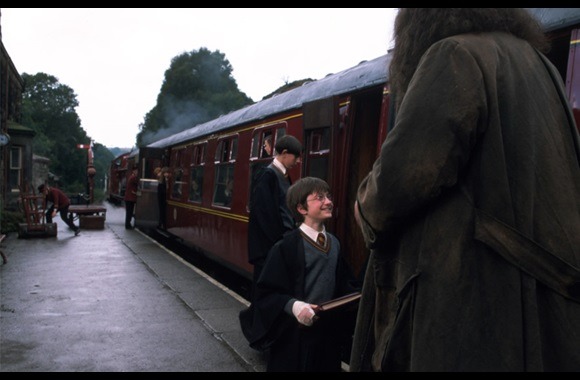
Filming began on Harry Potter and the Philosopher’s Stone on Friday 29th September 2000 and the Great Hall was one of the first sets to be built; a vast and impressive space that could seat more than 400 children. It subsequently became a key set which can be seen in seven Harry Potter films (the Great Hall does not appear in Harry Potter and the Deathly Hallows – Part 1) and now permanently resides at the Studio Tour for visitors to explore.
Included within the Great Hall set are a number of wall-mounted flambeaux (each one fully operational) which represent the four houses of Hogwarts – Gryffindor, Ravenclaw, Slytherin and Hufflepuff. Behind the teachers’ table sits an intricate House Point Counter, this beautiful mechanism was made for the first film, and each hour glass contains tens of thousands of Indian glass beads – rumour has it this caused a national bead shortage!
hourglass Flourish Here
HARRY POTTER AND THE CHAMBER OF SECRETS
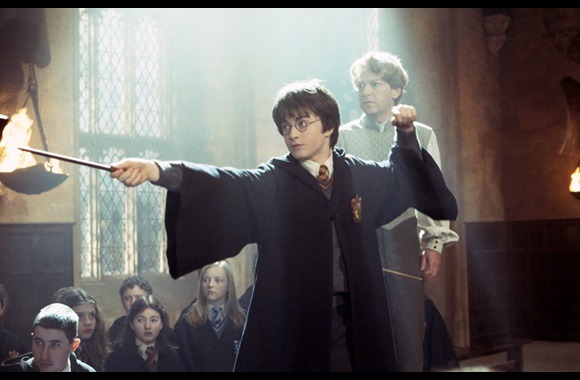
Production for Harry Potter and the Chamber of Secrets began on Monday 19th November 2001 – only three days after the widespread release of the first Harry Potter film.
This was the first time the audience met Dobby the house-elf. Rob Bliss, in the Art Department at Leavesden Studios, was responsible for conceptualising Dobby’s appearance, and Creature Effects Supervisor Nick Dudman and his team created an impressive model so that the cast could react to something on set. The whole process took three months and the final Dobby seen in the films was created using CGI (Computer Generated Imagery).
The iconic set for Dumbledore’s office was first built and created for this film. The office is surrounded by a large library of books which are, in fact, mostly telephone directories bound in leather!
hourglass Flourish Here
HARRY POTTER AND THE PRISONER OF AZKABAN
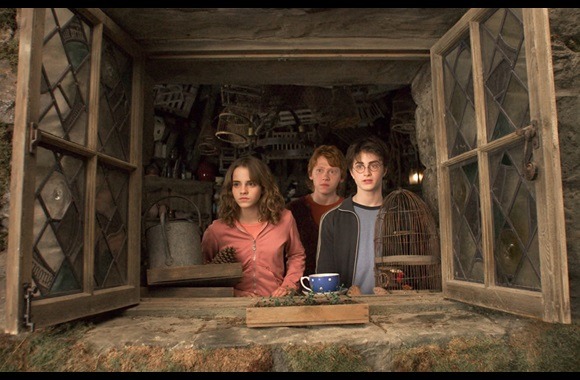
Principal photography for Harry Potter and the Prisoner of Azkaban began at Leavesden Studios on Monday 24th February 2003.
One of the most complicated set pieces to create was the Knight Bus, which appeared in this film. The audience sees the bus drive Harry through the streets of London and, despite its three decks, this was not achieved through CGI. The bus was driven to London, which required a lot of planning because the bus was specially built using components from two double-decker buses, in order to create a triple-decker. Taking the height of the bus into consideration, the route into London had to be carefully mapped out – bridges were clearly out of the question!
This film marked the first time the Dementor were introduced. Director Alfonso Cuaron and Producer David Heyman experimented with different methods to make it appear as if the Dementor were actually floating. Initially puppeteers were brought onto set, to move large pieces of cloth in a water tank which created the illusion that the Dementor were floating. However, this movement was later created through visual effects.
hourglass Flourish Here
HARRY POTTER AND THE GOBLET OF FIRE
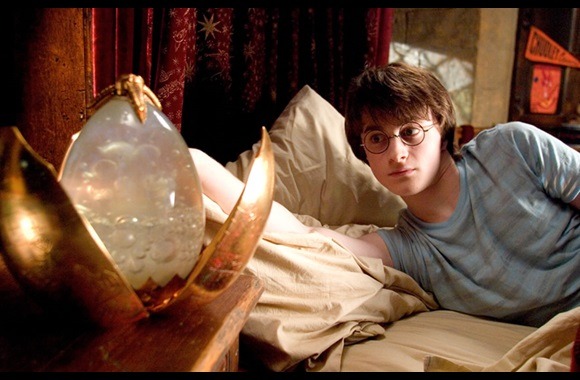
Filming for Harry Potter and the Goblet of Fire began on Tuesday 4th May 2004.
A giant water tank was built at the Studios to film the underwater scenes for the Triwizard Tournament. It is the largest underwater filming tank in Europe which is capable of holding over two million litres of water.
During filming, Daniel Radcliffe (Harry Potter) spent so much time under water in the dive tank he gained his PADI diving certificate. A lot of time was spent experimenting with how to make him look as if he had webbed hands. This look was eventually created using very fine ladies tights, which Daniel wore over his hands and up his arms!
John Richardson’s Special Effects Team built a fully operational, fire-breathing Hungarian Horntail dragon armed with a 35ft flame thrower for this film. Eventually, the filmmakers decided that the dragons would be created by the Visual Effects Team, but the dragon went on to take pride of place at the London premiere in Leicester Square.
hourglass Flourish Here
HARRY POTTER AND THE ORDER OF THE PHOENIX
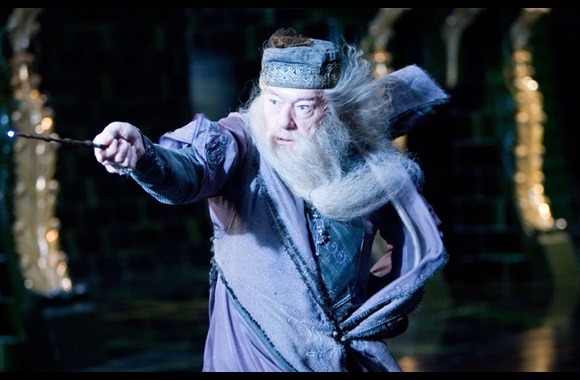
Harry Potter and the Order of the Phoenix began filming on Monday 6th February 2006.
In this film, the audience is introduced to the Ministry of Magic set for this first time. This set was the largest created for any of the Harry Potter films. In fact, 50 London buses could fit inside the Atrium of the Ministry of Magic and it took 22 weeks to build. The set is inspired by the Victorian architecture of London, particularly the tiles, which may look authentic but are actually made of MDF!
The fifth film also saw the series’ first ever complete blue screen set, as the Hall of Prophecies was shot entirely against a blue screen backdrop.
Forty adorable kittens were filmed for the garish plates in Umbridge’s office –these kittens went on to be domestic pets and their new owners were unaware of their famous origins.
hourglass Flourish Here
HARRY POTTER AND THE HALF-BLOOD PRINCE
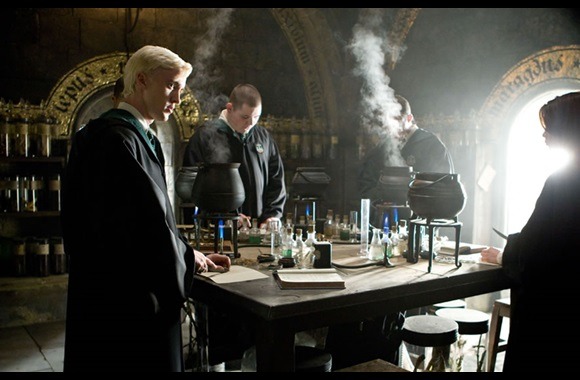
Principal photography began on the sixth film, Harry Potter and the Half-Blood Prince, on Monday 24th September 2007.
During filming Rupert Grint (Ron Weasley) turned 21 and the cast and crew celebrated with a children’s-themed party in the studio canteen.
In this film a model of The Burrow was set ablaze and partially destroyed. Afterwards, the entire interior part of the set (inside and out) was rebuilt and re-dressed on the studio backlot for the final films. The charred walls were given a quick coat of whitewash and, of course, the set retained all of the familiar Weasley touches.
hourglass Flourish Here
HARRY POTTER AND THE DEATHLY HALLOWS – PART 1 AND 2
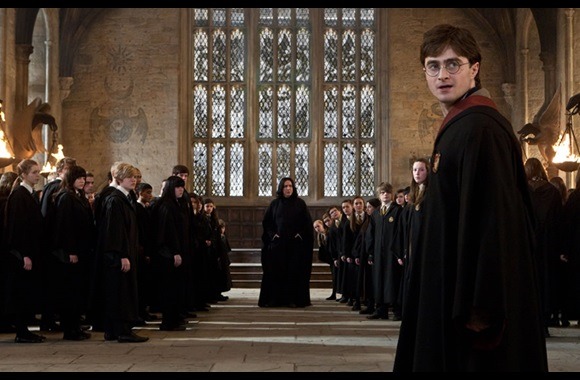
Harry Potter and the Deathly Hallows – Part 1 began filming on Thursday 19th February 2009, and the second installment, Harry Potter and the Deathly Hallows – Part 2, was filmed back-to-back with Part 1.
Five 32-ton trucks worth of polystyrene were needed, to create all the rubble for the destruction of Hogwarts at the end of the final film.
Daniel Radcliffe went through 160 pairs of glasses and around 70 wands during filming for the Harry Potter film series. Over the ten years, an incredible 588 sets were created at Leavesden Studios.



